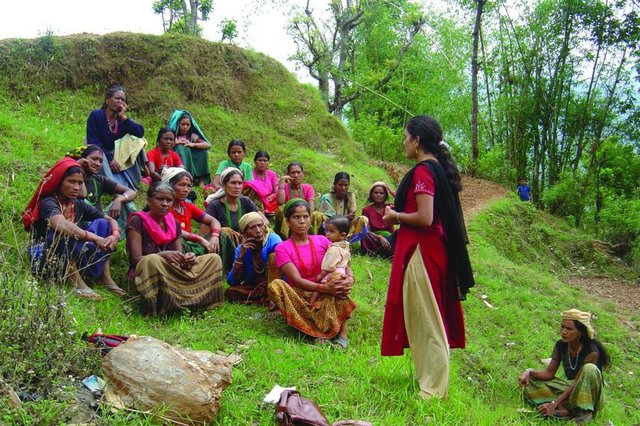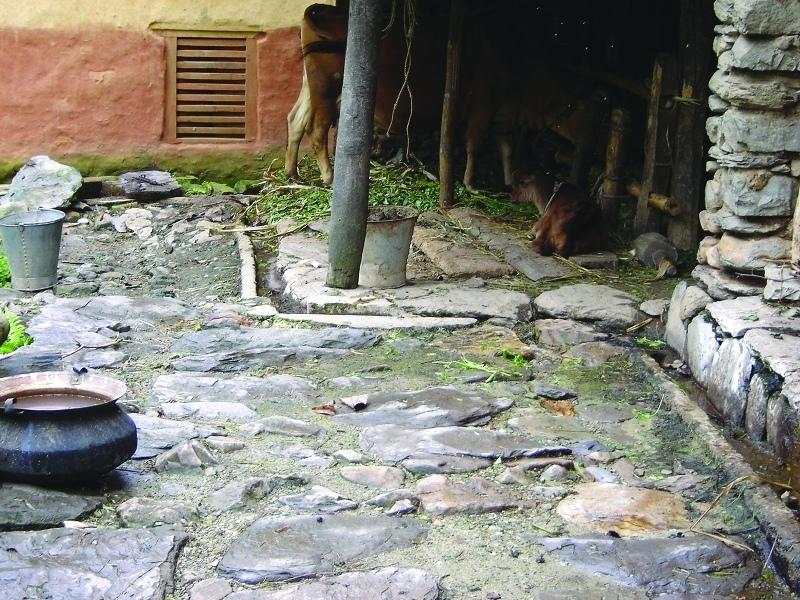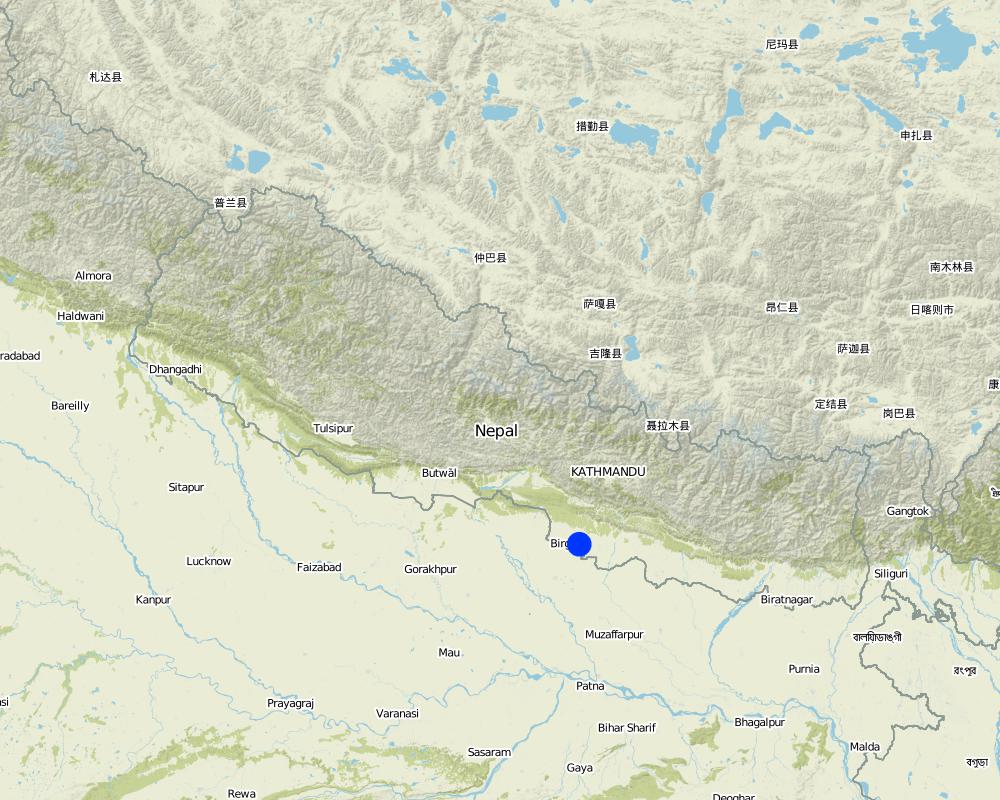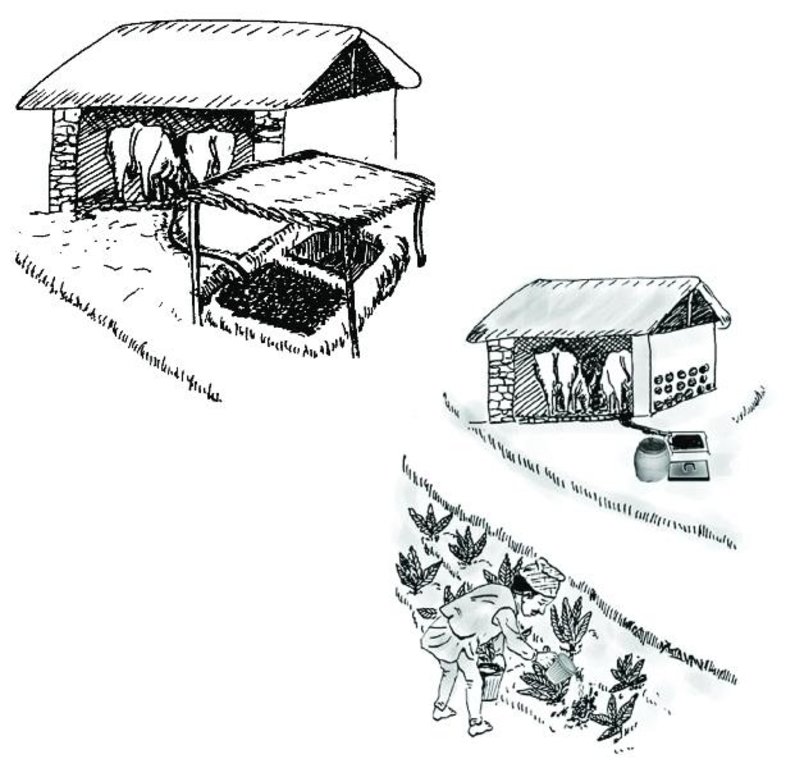Improved cattleshed for urine collection [尼泊尔]
- 创建:
- 更新:
- 编制者: Richard Allen
- 编辑者: –
- 审查者: David Streiff, Alexandra Gavilano
Mutra sankalan ka lagi sudhariyeko goth (Nepali)
technologies_1752 - 尼泊尔
查看章节
全部展开 全部收起1. 一般信息
1.2 参与该技术评估和文件编制的资源人员和机构的联系方式
SLM专业人员:
Director
Soil Management Directorate, Department of Agriculture
尼泊尔
SLM专业人员:
Team Leader
Sustainable Soil Management Programme
尼泊尔
有助于对技术进行记录/评估的项目名称(如相关)
Sustainable Soil Management Programme, Nepal (SSMP)有助于对技术进行记录/评估的机构名称(如相关)
HELVETAS (Swiss Intercooperation)有助于对技术进行记录/评估的机构名称(如相关)
Department of Agriculture, Soil Management Directorate, Hariharbhawan Lalitpur (doasoil) - 尼泊尔1.3 关于使用通过WOCAT记录的数据的条件
编制者和关键资源人员接受有关使用通过WOCAT记录数据的条件。:
是
1.5 参考关于SLM方法(使用WOCAT记录的SLM方法)的调查问卷

Farmer field schools on integrated plant nutrient systems [尼泊尔]
Participatory and collaborative learning through the farmer field school approach
- 编制者: Richard Allen

Farmer-led experimentation [尼泊尔]
Participatory technology testing and adaptation through farmer-led experiments
- 编制者: Richard Allen

Farmer-to-farmer diffusion [尼泊尔]
Wider diffusion of sustainable soil management technologies through a demand responsive farmer-to-farmer diffusion approach
- 编制者: Richard Allen
2. SLM技术的说明
2.1 技术简介
技术定义:
Collection of cattle urine in improved cattle sheds for use as liquid manure and organic pesticide
2.2 技术的详细说明
说明:
Nitrogen is the most important macronutrient for plants, and high crop productivity can only be achieved by making sufficient nitrogen available to crops. Nitrogen is also the most limiting nutrient in farms across Nepal’s midhills. Traditionally farmers applied farmyard manure to fertilise their needs. In many places this is being supplemented or even entirely replaced by inorganic fertiliser - mainly urea. The price of inorganic fertiliser has increased continuously in recent years and it is only available in limited quantities in areas far from the roadheads. On the other hand, cultivation practices are intensifying with increased cropping intensities and more nutrient-demanding crops as, for example, local varieties are replaced by hybrids and new crops are grown. This can easily lead to declining soil fertility and nutrient mining if it is not compensated for by an equivalent increase in organic or mineral fertilisation.
Cattle urine is a viable alternative to mineral fertiliser. Of the nitrogen excreted by cattle, 60% is found in the urine and only 40% in dung. In traditional sheds, urine is left to be absorbed in the bedding material, while excess urine is channelled out of the shed and disposed of. The technology described here - improved cattle sheds- are designed for collecting the urine in a pit or drum. This pit is generally located in the shed itself or just outside connected to the drainage channel through a pipe and protected from rain and runoff. Where urine is collected for incorporation in farmyard manure, the pit may be directly connected to the manure pit or heap. Urine that is going to be used as liquid manure or organic pesticide has to be stored in a drum for fermentation.
A household with two cattle can save the equivalent of purchasing about 100 kg of urea over one year by applying urine either directly as liquid fertiliser or as a component in improved farmyard manure.
2.3 技术照片
2.5 已应用该技术的、本评估所涵盖的国家/地区/地点
国家:
尼泊尔
有关地点的进一步说明:
Midhill districts of Nepal
Map
×3. SLM技术的分类
3.1 该技术的主要目的
- Collect fertilizer
3.2 应用该技术的当前土地利用类型

农田
- 一年一作
注释:
Major land use problems (compiler’s opinion): Intensifying cultivation practices with either 1) inadequate application of fertilisers leading to a decline in soil fertility and the mining of soil nutrients or 2) application of too much fertiliser causing environmental problems through excessive leaching, and losses of fertiliser in surface runoff and consequent eutrophication or nitrification of streams, ponds, or groundwater.
3.5 该技术所属的SLM组
- 土壤肥力综合管理
3.6 包含该技术的可持续土地管理措施

管理措施
- M6:废物管理(回收、再利用或减少)
注释:
Main measures: management measures
3.7 该技术强调的主要土地退化类型

化学性土壤退化
- Cn:肥力下降和有机质含量下降(非侵蚀所致)
3.8 防止、减少或恢复土地退化
具体数量名该技术与土地退化有关的目标:
- 不适用
4. 技术规范、实施活动、投入和成本
4.1 该技术的技术图纸
技术规范(与技术图纸相关):
a) Urine collection and direct incorporation in covered farmyard manure pit.
b) Urine collection for later application as liquid manure or organic pesticide.
Technical knowledge required for field staff / advisors: low
Technical knowledge required for land users: low
Main technical functions: increase in organic matter, increase in soil fertility, increase in soil productivity, pest control
Secondary technical functions: supplementary irrigation
4.2 有关投入和成本计算的一般信息
具体说明成本和投入是如何计算的:
- 每个技术单元
指定单位:
Urine collection system
具体说明成本计算所用货币:
- 美元
注明雇用劳工的每日平均工资成本:
2.00
4.3 技术建立活动
| 活动 | 时间(季度) | |
|---|---|---|
| 1. | Provide slight slope to the cattle shed floor | |
| 2. | Dig a draining ditch and a collection pit, if possible at the lowest point inside the shed. If this is not possible, an outside pit should be dug, protected from rain and runoff, and connected with the draining ditch through a pipe or a channel. | |
| 3. | Make the floor as impermeable as possible; e.g. with cement (expensive and durable), stone slabs, soil compaction, or clay (cheap but not durable). The more impermeable the floor, the more urine can be collected. | |
| 4. | Provide a jug/’decapitated’ plastic bottle/cup/etc. to scoop the urine out of the collection pit into the fermentation drum. |
4.4 技术建立所需要的费用和投入
| 对投入进行具体说明 | 单位 | 数量 | 单位成本 | 每项投入的总成本 | 土地使用者承担的成本% | |
|---|---|---|---|---|---|---|
| 劳动力 | Labour | per unit | 1.0 | 6.0 | 6.0 | 100.0 |
| 施工材料 | Plastic drum | per unit | 6.0 | 1.0 | 6.0 | 100.0 |
| 技术建立所需总成本 | 12.0 | |||||
| 技术建立总成本,美元 | 12.0 | |||||
注释:
Duration of establishment phase: 0.25 month(s)
4.5 维护/经常性活动
| 活动 | 时间/频率 | |
|---|---|---|
| 1. | When the collection pit is full, the collected urine has to be removed from the pit and stored in a plastic drum for fermentation. | |
| 2. | The urine is applied as liquid fertiliser by jug or through drip irrigation. |
4.6 维护/经常性活动所需要的费用和投入(每年)
注释:
It is clear that cattle or buffaloes are required for urine production. To help farmers to use their own resources, it is suggested to start with the cheapest and simplest form of urine collection and a compacted sloping floor and a collection pit within the shed. This allows the farmer to see the benefits of collecting the urine and will encourage them to invest in more expensive materials to improve the efficiency of urine collection. Cost as in January 2007
5. 自然和人文环境
5.1 气候
年降雨量
- < 250毫米
- 251-500毫米
- 501-750毫米
- 751-1,000毫米
- 1,001-1,500毫米
- 1,501-2,000毫米
- 2,001-3,000毫米
- 3,001-4,000毫米
- > 4,000毫米
有关降雨的规范/注释:
Annual rainfall: Also 2000-3000 mm
农业气候带
- 潮湿的
Thermal climate class: subtropics
5.2 地形
平均坡度:
- 水平(0-2%)
- 缓降(3-5%)
- 平缓(6-10%)
- 滚坡(11-15%)
- 崎岖(16-30%)
- 陡峭(31-60%)
- 非常陡峭(>60%)
地形:
- 高原/平原
- 山脊
- 山坡
- 山地斜坡
- 麓坡
- 谷底
垂直分布带:
- 0-100 m a.s.l.
- 101-500 m a.s.l.
- 501-1,000 m a.s.l.
- 1,001-1,500 m a.s.l.
- 1,501-2,000 m a.s.l.
- 2,001-2,500 m a.s.l.
- 2,501-3,000 m a.s.l.
- 3,001-4,000 m a.s.l.
- > 4,000 m a.s.l.
关于地形的注释和进一步规范:
Slopes on average: Also moderate (6-10%), rolling (11-15%) and hilly (16-30%)
Landforms: Also footslopes
Altitudinal zone: Also 1000-1500 m a.s.l. and 1500-2000 m a.s.l.
5.6 应用该技术的土地使用者的特征
生产系统的市场定位:
- 生计(自给)
- 商业/市场
个人或集体:
- 个人/家庭
说明土地使用者的其他有关特征:
Off-farm income specification: In most farm households, off-farm income plays at least a minor and increasingly a major role. Occasional opportunities for off-farm income present themselves in the form of daily labour wages. Some households’ members receive regular salaries, whilst an increasing number of Nepalis are working in India, the Middle East, Malaysia, and elsewhere and sending remittance incomes home.
5.7 应用该技术的土地使用者使用的平均土地面积
- < 0.5 公顷
- 0.5-1 公顷
- 1-2 公顷
- 2-5公顷
- 5-15公顷
- 15-50公顷
- 50-100公顷
- 100-500公顷
- 500-1,000公顷
- 1,000-10,000公顷
- > 10,000公顷
5.8 土地所有权、土地使用权和水使用权
土地所有权:
- 个人,未命名
- 个人,有命名
土地使用权:
- 租赁
- 个人
6. 影响和结论性说明
6.1 该技术的现场影响
社会经济效应
收入和成本
农业投入费用
注释/具体说明:
Reduced expenses for agrochemicals
其它社会经济效应
Shed management and cleaning
Organic crop production
Animal health
Establishment costs if cement is used
社会文化影响
Social prestige as seen as progressive farmer
Handling of dung and urine
生态影响
其它生态影响
Eutrophication and nitrification of waterbodies due to controlled outflow of urine
6.2 该技术的场外影响已经显现
地下水/河流污染
注释/具体说明:
Reduction of nutrient influx into water bodies
Dependence on outside inputs
6.4 成本效益分析
技术收益与技术建立成本相比如何(从土地使用者的角度看)?
短期回报:
积极
长期回报:
积极
技术收益与技术维护成本/经常性成本相比如何(从土地使用者的角度看)?
短期回报:
积极
长期回报:
积极
注释:
The high cost of mineral fertiliser means that the establishment costs are soon recovered. In the long-term, the major reduction in fertiliser cost leads to increased benefits.
6.5 技术采用
注释:
Comments on spontaneous adoption: Approximately 30% of SSMP supported farmers groups and about 15% none members of SSMP supported groups adopted the tehnology.
6.7 该技术的优点/长处/机会
| 编制者或其他关键资源人员认为的长处/优势/机会 |
|---|
|
The use of urine collected on-farm reduced the requirement for mineral fertiliser which reduced production costs and outside dependency How can they be sustained / enhanced? Further promotion of the technology will increase this impact |
|
Human urine can also be used to fertilise crops, but needs to be fermented longer and may be socially less accepted How can they be sustained / enhanced? Promote the use of urine further and show there is no problem with using human urine |
|
Applying urine as a liquid manure also irrigates the crops (fertigation) How can they be sustained / enhanced? The link between urine application and drip irrigation, or other forms of smallscale irrigation, should be promoted. It has been tested and applied successfully by farmers related to SSMP in Syangja and Surkhet in western Nepal |
6.8 技术的弱点/缺点/风险及其克服方法
| 编制者或其他关键资源人员认为的弱点/缺点/风险 | 如何克服它们? |
|---|---|
| The initial costs incurred whilst improving a durable shed using cement may hinder adoption | Simpler methods such as using clay soil, compacting the fl oor, and using stone slates may, however lead to less urine being collected |
| Project incentives (cement, plastic drum) have hindered adoption in some places |
No incentives should be provided, rather very simple methods should be demonstrated and adapted to local conditions |
| Urine collection is feasible for subsistence farm households or small scale commercial producers. It may, however, not be applicable for larger scale commercial vegetable producers as a balance between area needed for livestock and growing the crops is needed | Urine could become a tradeable commodity which would see large-scale livestock producers selling their urine to large-scale vegetable producers. |
7. 参考和链接
7.1 信息的方法/来源
7.2 参考可用出版物
标题、作者、年份、ISBN:
STSS; SSMP (2001) Farmyard Manure and Compost Management (in Nepali). Kathmandu: Soil Testing Services Section, Department of Agriculture and Sustainable Soil Management Programme
可以从哪里获得?成本如何?
SSMP
链接和模块
全部展开 全部收起链接

Farmer field schools on integrated plant nutrient systems [尼泊尔]
Participatory and collaborative learning through the farmer field school approach
- 编制者: Richard Allen

Farmer-led experimentation [尼泊尔]
Participatory technology testing and adaptation through farmer-led experiments
- 编制者: Richard Allen

Farmer-to-farmer diffusion [尼泊尔]
Wider diffusion of sustainable soil management technologies through a demand responsive farmer-to-farmer diffusion approach
- 编制者: Richard Allen
模块
无模块





